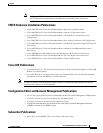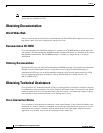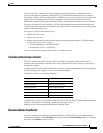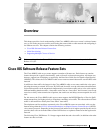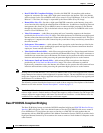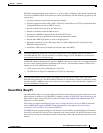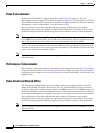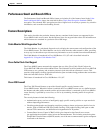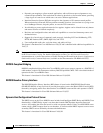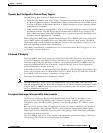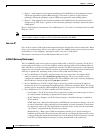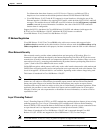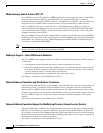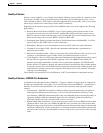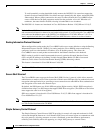
1-5
Cisco uBR924 Software Configuration Guide
OL-0337-05 (8/2002)
Chapter 1 Overview
Cisco IOS Software Release Feature Sets
Performance Small and Branch Office
The Performance Small and Branch Office feature set includes all of the features found in the Value
Small and Branch Office image, but adds 168-bit IPsec Triple Data Encryption Standard (3DES)
encryption. The advanced IPsec encryption provides a higher-level of security to protect very sensitive
information, such as medical and banking records.
Feature Descriptions
This section describes the particular features that are contained in the feature sets supported by the
Cisco uBR924 cable access router. See the Release Notes for any particular release for information on
which features are contained in a particular Cisco IOS image.
Cable Monitor Web Diagnostics Tool
The Cable Monitor is a web-based diagnostic tool to display the current status and configuration of the
Cisco uBR924 router. The Cable Monitor can also be used when the cable network is down, providing
an easy way for subscribers to provide necessary information to service technicians and troubleshooters.
The Cable Monitor is introduced in Cisco IOS Release 12.1(1)T and is described in detail in
Appendix B, “Using the Cable Monitor Tool.”
Cisco Cable Clock Card Support
The Cisco uBR924 router automatically supports the use of the Cisco Cable Clock Card on the
Cisco uBR7246 VXR universal broadband router. The National Clock Card enables the Cisco uBR7246
VXR router to use a primary and secondary external clock derived from a Stratum 1 source. This
provides a high quality clocking signal that minimizes jitter and other timing problems that can interfere
with real-time traffic such as VoIP calls.
This feature is introduced in Cisco IOS Release 12.1(1)T.
Cisco IOS Firewall
The Cisco IOS Firewall feature set provides firewall-specific security features to the
Cisco uBR924 router. When this feature is enabled, the Cisco uBR924 router acts as a buffer between
the Internet and other public networks and the private network that is connected to the Cisco uBR924
router. Security is provided by access lists, as well as by examining incoming traffic for suspicious
activity.
The security features include the following:
• Authentication proxy services to intelligently apply specific security policies on a per-user basis
without impacting performance.
• Checking packet headers and dropping suspicious packets to detect and prevent denial of service
attacks, such as ICMP and UDP echo packet flooding, SYN packet flooding, half-open or other
unusual TCP connections, and deliberate mis-fragmentation of IP packets.
• Context-Based Access Control (CBAC) which gives internal-to-the-firewall users secure,
per-application-based traffic control across the Internet/Intranet. This includes protection against
Simple Mail Transfer Protocol (SMTP) attacks, one of the most common attacks against computers
connected to the Internet.



